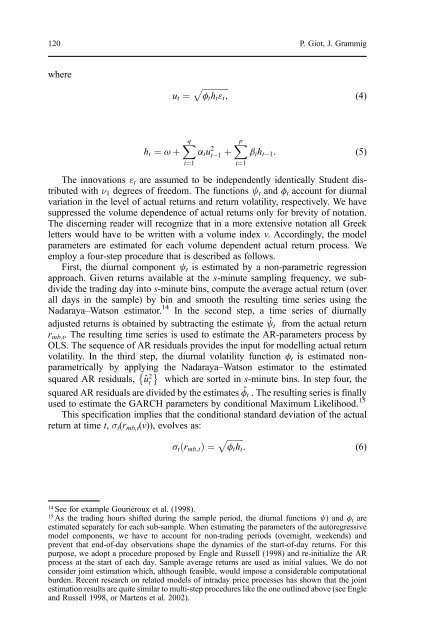recent developments in high frequency financial ... - Index of
recent developments in high frequency financial ... - Index of
recent developments in high frequency financial ... - Index of
You also want an ePaper? Increase the reach of your titles
YUMPU automatically turns print PDFs into web optimized ePapers that Google loves.
120<br />
where<br />
ht ¼ ! þ Xq<br />
ut ¼ ffiffiffiffiffiffiffiffiffiffiffiffiffi p<br />
tht"t;<br />
i¼1<br />
iu 2 Xp<br />
t 1 þ<br />
i¼1<br />
(4)<br />
iht 1: (5)<br />
The <strong>in</strong>novations "t are assumed to be <strong>in</strong>dependently identically Student distributed<br />
with ν1 degrees <strong>of</strong> freedom. The functions t and t account for diurnal<br />
variation <strong>in</strong> the level <strong>of</strong> actual returns and return volatility, respectively. We have<br />
suppressed the volume dependence <strong>of</strong> actual returns only for brevity <strong>of</strong> notation.<br />
The discern<strong>in</strong>g reader will recognize that <strong>in</strong> a more extensive notation all Greek<br />
letters would have to be written with a volume <strong>in</strong>dex v. Accord<strong>in</strong>gly, the model<br />
parameters are estimated for each volume dependent actual return process. We<br />
employ a four-step procedure that is described as follows.<br />
First, the diurnal component t is estimated by a non-parametric regression<br />
approach. Given returns available at the s-m<strong>in</strong>ute sampl<strong>in</strong>g <strong>frequency</strong>, we subdivide<br />
the trad<strong>in</strong>g day <strong>in</strong>to s-m<strong>in</strong>ute b<strong>in</strong>s, compute the average actual return (over<br />
all days <strong>in</strong> the sample) by b<strong>in</strong> and smooth the result<strong>in</strong>g time series us<strong>in</strong>g the<br />
Nadaraya–Watson estimator. 14 In the second step, a time series <strong>of</strong> diurnally<br />
adjusted returns is obta<strong>in</strong>ed by subtract<strong>in</strong>g the estimate ^ t from the actual return<br />
r mb,t. The result<strong>in</strong>g time series is used to estimate the AR-parameters process by<br />
OLS. The sequence <strong>of</strong> AR residuals provides the <strong>in</strong>put for modell<strong>in</strong>g actual return<br />
volatility. In the third step, the diurnal volatility function t is estimated nonparametrically<br />
by apply<strong>in</strong>g the Nadaraya–Watson estimator to the estimated<br />
squared AR residuals, ^u 2 t which are sorted <strong>in</strong> s-m<strong>in</strong>ute b<strong>in</strong>s. In step four, the<br />
squared AR residuals are divided by the estimates ^ t . The result<strong>in</strong>g series is f<strong>in</strong>ally<br />
used to estimate the GARCH parameters by conditional Maximum Likelihood. 15<br />
This specification implies that the conditional standard deviation <strong>of</strong> the actual<br />
return at time t, σt(rmb,t(v)), evolves as:<br />
ð Þ ¼ ffiffiffiffiffiffiffiffi p<br />
: (6)<br />
t rmb;t<br />
14 See for example Gouriéroux et al. (1998).<br />
15 As the trad<strong>in</strong>g hours shifted dur<strong>in</strong>g the sample period, the diurnal functions ) and t are<br />
estimated separately for each sub-sample. When estimat<strong>in</strong>g the parameters <strong>of</strong> the autoregressive<br />
model components, we have to account for non-trad<strong>in</strong>g periods (overnight, weekends) and<br />
prevent that end-<strong>of</strong>-day observations shape the dynamics <strong>of</strong> the start-<strong>of</strong>-day returns. For this<br />
purpose, we adopt a procedure proposed by Engle and Russell (1998) and re-<strong>in</strong>itialize the AR<br />
process at the start <strong>of</strong> each day. Sample average returns are used as <strong>in</strong>itial values. We do not<br />
consider jo<strong>in</strong>t estimation which, although feasible, would impose a considerable computational<br />
burden. Recent research on related models <strong>of</strong> <strong>in</strong>traday price processes has shown that the jo<strong>in</strong>t<br />
estimation results are quite similar to multi-step procedures like the one outl<strong>in</strong>ed above (see Engle<br />
and Russell 1998, or Martens et al. 2002).<br />
tht<br />
P. Giot, J. Grammig










